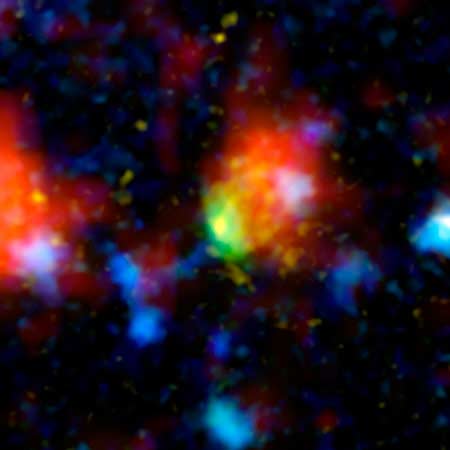Cosmic Baby Boom Baffles Astronomers

Our galaxy cranks out about 10 new stars per year. Now astronomers have found one near the beginning of time that's generating a whopping 4,000 a year. At that rate, the galaxy needs only 50 million years to grow into one equivalent to the most massive ever observed.
Such rapid-fire starbirth and growth confounds theory.
In the so-called Hierarchical Model of galaxy formation, galaxies are supposed to slowly bulk up their stars over time by absorbing tiny pieces of galaxies, rather than in one big burst.
"This galaxy is undergoing a major baby boom, producing most of its stars all at once," said Peter Capak of NASA's Spitzer Science Center at Caltech. "If our human population was produced in a similar boom, then almost all of the people alive today would be the same age."
The galaxy is 12.3 billion light-years away, so the light astronomers are observing was emitted when the universe was just a billion years old. It is the brightest starburst galaxy ever spotted in the distant universe. Other galaxies with such rapid rates of star formation are nearby and thus much more evolved.
"If the universe was a human reaching retirement age, it would have been about 6 years old at the time we are seeing this galaxy," Capak said.
"Before now, we had only seen galaxies form stars like this in the teenaged universe, but this galaxy is forming when the universe was only a child," he explained. "The question now is whether the majority of the very most massive galaxies form very early in the universe like the Baby Boom galaxy, or whether this is an exceptional case. Answering this question will help us determine to what degree the Hierarchical Model of galaxy formation still holds true."
Get the Space.com Newsletter
Breaking space news, the latest updates on rocket launches, skywatching events and more!
When stars are born, they shine with a lot of ultraviolet light and produce a lot of dust. The dust absorbs the ultraviolet light but, like a car sitting in the sun, it warms up and re-emits light at infrared and submillimeter wavelengths, making the galaxy unusually bright in this portion of the light spectrum.
The discovery was made using several telescopes, including NASA's Spitzer and Hubble space telescopes and the James Clerk Maxwell Telescope and Subaru Telescope in Hawaii. It is detailed in the July 10 issue of Astrophysical Journal Letters.
"We may be witnessing, for the first time, the formation of one of the most massive elliptical galaxies in the universe," said study co-author Nick Scoville of Caltech.
- The Strangest Things in Space
- VOTE: The Most Amazing Views from Space
- What is a Theory?
Join our Space Forums to keep talking space on the latest missions, night sky and more! And if you have a news tip, correction or comment, let us know at: community@space.com.

Space.com is the premier source of space exploration, innovation and astronomy news, chronicling (and celebrating) humanity's ongoing expansion across the final frontier. Originally founded in 1999, Space.com is, and always has been, the passion of writers and editors who are space fans and also trained journalists. Our current news team consists of Editor-in-Chief Tariq Malik; Editor Hanneke Weitering, Senior Space Writer Mike Wall; Senior Writer Meghan Bartels; Senior Writer Chelsea Gohd, Senior Writer Tereza Pultarova and Staff Writer Alexander Cox, focusing on e-commerce. Senior Producer Steve Spaleta oversees our space videos, with Diana Whitcroft as our Social Media Editor.









